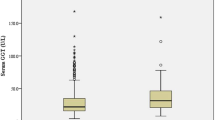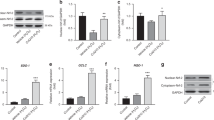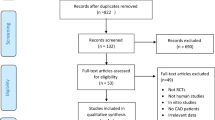Abstract
The purpose of our research is to explore whether vitamin D levels were associated with the rupture of intracranial aneurysms. In this retrospective study, 105 patients diagnosed with ruptured intracranial aneurysms (RIAs) and 185 patients diagnosed with unruptured intracranial aneurysms (UIAs) at The First Affiliated Hospital of Zhengzhou University were recruited from September 2019 to September 2020. Patients’ demographic and clinical information, including vitamin D levels, were recorded and compared. Univariate analysis showed that patients with UIAs had higher vitamin D levels than RIAs (p = 0.019). In addition, there were significant differences in aneurysm location (p < 0.001), aspirin use (p = 0.001), and comorbid diabetes mellitus (p = 0.037) between patients with UIAs and RIAs. Binary logistic regression analysis showed that the level of vitamin D was independently associated with RIAs [odds ratio (OR) 0.960; 95% confidence intervals (CI), 0.926–0.996, p = 0.028].
Similar content being viewed by others
Introduction
There is increasing evidence regarding the role of vitamin D in extra-skeletal biological functions1,2. Previous studies have found the relationship between vitamin D and arterial diseases3,4,5, whether it is an occlusive or aneurysmal disease, such as acute coronary syndrome, abdominal aortic aneurysm, as well as a stroke. Interestingly, low vitamin D status seems to be independent of traditional vascular risk factors by an independent effect of the vitamin D receptor (VDR) on the arterial wall6. Hypovitaminosis D may be involved in the processes of atherosclerosis and arterial aging, including the reduction of smooth muscle cell proliferation, resulting in vascular inflammation that can lead to damaged endothelial cells7,8,9.
Intracranial aneurysms (IAs), which are pathological dilations in major branching brain arteries, may cause serious cerebrovascular disease events, such as subarachnoid hemorrhage (SAH), a type of stroke with high disability and mortality10. More attention is paid to the risk factors associated with aneurysm rupture, including age, hypertension, previous SAH from another aneurysm, size and site of the aneurysm, and geographical region11,12. In recent years, a few studies have considered hypovitaminosis D to be connected with intracranial aneurysms13, but the relationship between vitamin D and intracranial aneurysm rupture is poorly understood. In this study, we explored whether vitamin D levels are associated with the rupture of intracranial aneurysms. We performed a case–control study to test the hypothesis of a positive association between vitamin D and ruptured IA (RIAs).
Patients and methods
Subjects
This was a retrospective case–control study, and the participants consisted of patients with intracerebral aneurysms treated between September 2019 to September 2020 at The First Affiliated Hospital of Zhengzhou University. Patients with unruptured intracranial aneurysms (UIAs) were defined as those having at least one intracranial unruptured aneurysm confirmed by imaging digital subtraction angiography (DSA), regardless of the presence of clinical symptoms. Patients with ruptured intracranial aneurysms were defined as those having aneurysmal cerebral hemorrhage, confirmed by computed tomography (CT), and were diagnosed by DSA. The exclusion criteria were as follows: (1) intake of vitamin D supplements or glucocorticoids 3 months prior; (2) patients with other intracranial vascular malformations, such as arteriovenous malformations or arteriovenous fistulas; and (3) patients with fusiform, traumatic, bacterial, or dissecting aneurysms, or SAH of unknown origin.
A total of 290 patients were included in this study. Written informed consent was obtained from all the patients before enrollment. The study was conducted in accordance with the Declaration of Helsinki and approved by the ethics committee of the First Affiliated Hospital of Zhengzhou University.
Baseline information and clinical assessment
The following factors of the participants were recorded: age, sex, hypertension, diabetes mellitus, hyperlipidemia, heart disease, stroke, aspirin use, and the characteristics of the aneurysm (including the location and aneurysm size). In this study, the aneurysm size was equal to the maximum diameter. We also examined alcohol consumption and smoking status. Smoking and alcohol use were defined as ongoing alcohol use. We measured the levels of vitamin D, calcium and phosphorus in the morning of the first to second day after admission at the same time. Vitamin D levels were expressed by 25-hydroxy vitamin D. Blood calcium and phosphorus levels were also recorded.
Vitamin D measurements
Quantitative determination of total 25-hydroxy (25-OH) vitamin D was performed using the electrochemical luminescence assay method on an e-602 Hitachi Roche Modular system machine (Roche Diagnostics, Cobas e602/2010/Japan, Basel, Switzerland).
Statistical analysis
Statistical analysis was performed using SPSS software (version 23.0; SPSS, Inc. IBM Corp., Armonk, NY, USA). Numerical variables were described as the mean ± SD. Categorical variables were described by grouped data and percentages, and rates or percentages between the groups were compared with the χ2 test. Bivariate comparisons were performed using independent sample t-tests (continuous variables) and χ2 tests (categorical variables). Variables showing p < 0.10, in the univariate analysis, were assessed in binary logistic regression models. Age and sex (females) were also included. All confidence intervals were set at the 95% limits. Statistical significance was set at a two-tailed p value of < 0.05.
Result
Demographic and clinical characteristics at baseline are shown in Table 1. This study enrolled 290 patients with IAs. There were 105 (36.21%) patients with RIAs and 185 (63.79%) with UIAs; 67.24% (n = 195) were female, and the average age was 57.19 ± 11.64 years. Age and sex were distributed homogenously between the two groups (p = 0.332 and p = 0.145, respectively). The proportion of patients with diabetes mellitus was higher in the UIA group than in the RIA group (16.22% vs. 7.62%, respectively, p = 0.037). Moreover, there were more patients use aspirin in the UIAs group (13.51% vs. 1.90%, respectively, p = 0.001). In the RIAs group, 17 (16.19%) patients had aneurysms located at the MCA, 40 (38.10%) at the ICA, 29 (27.62%) at the ACA, and 19 (18.10%) at the posterior circulation. Additionally, 37 (20.00%) aneurysms were located in the MCA, 113 (61.08%) aneurysms at the ICA, 17 (9.19%) at the ACA, and 18 (9.73%) at the posterior circulation were not ruptured. Although the proportion of ICA aneurysms was the highest in both groups, there was a significant difference (p < 0.001). It is worth noting that vitamin D levels were significantly higher among those with UIAs compared to those with RIAs (19.28 ± 7.91 vs. 16.86 ± 9.167, respectively, p = 0.019). There were no significant differences in other clinical indicators, including hypertension, smoking, alcohol use, heart disease, stroke, aneurysm size, season, and blood calcium and phosphorus status between the two groups (all p > 0.05).
Table 2 summarizes the results of the binary logistic regression analysis comparing the RIAs and UIAs, which indicated that levels of vitamin D were independently associated with aneurysm rupture (OR 0.960; 95% CI 0.926–0.996, p = 0.028). Moreover, the use of aspirin (OR 0.083; 95% CI 0.017–0.399, p = 0.002) and aneurysm location (MCA, ICA, and ACA compared with aneurysms of the posterior circulation) (p < 0.001) were still independently associated with RIAs. Internal carotid artery location was inversely associated with RIAs (OR 0.364; 95% CI 0.168–0.788, p = 0.010).
Discussion
This retrospective, case–control study suggests that vitamin D levels are independently associated with ruptured cerebral aneurysms.
Previous studies on vitamin D and RIAs are limited. In one descriptive study13, 25-hydroxy vitamin D levels were significantly lower in the aneurysm group than in the control group (patients without a history of cerebral aneurysm treatment). However, they did not show a significant difference in 25-hydroxy vitamin D levels between the ruptured and unruptured aneurysm subgroups. Yarelis Alvarado Reyes et al.14 observed 40 patients with aneurysmal subarachnoid hemorrhage (aSAH), and they found a high prevalence of vitamin D deficiency among them, but no difference in clinical outcomes (including death, vasospasm hydrocephalus requiring external ventricular drain, or infections) was observed in patients when compared with the vitamin D group. In addition, because all the experimenters were diagnosed with aSAH, they could not compare their vitamin D levels with those of patients with UIAs.
Some epidemiological studies have reported a correlation between extracranial artery dilatation, aneurysms, and vitamin D deficiency15,16. As Demir et al. previously reported, vitamin D deficiency is an independent factor associated with thoracic aortic dilatation (TAD) formation17. In an observational study of 311 elderly men with abdominal aortic aneurysm (AAA), lower vitamin D status was associated with a larger abdominal aortic aneurysm18. However, they did not study whether vitamin D deficiency was associated with ruptured aneurysms.
Vitamin D appears to exert anti-inflammatory effects19. It modulates the activation, proliferation, and differentiation of inflammatory cells through the vitamin D receptor (VDR)20,21. More specifically, it could reduce the production of type 1 proinflammatory cytokines (IL-12, IFN-g, IL-6, IL-8, tumor necrosis factor-a, IL-17, and IL-9) and increases the production of type 2 anti-inflammatory cytokines (IL-4, IL-5, and IL-10)22. Several studies have found a relationship between inflammatory response and aneurysm rupture. Researchers have found that vessel wall inflammation (arterial wall enhancement can be used as an indirect marker of vessel wall inflammation) may predict an unsteady state of intracranial aneurysms23,24. In addition, Hasan et al. found that the use of anti-inflammatory medications (aspirin) significantly reduced the risk of aneurysm rupture25. This is consistent with the results of our study. Therefore, we speculate that vitamin D may be related to aneurysm rupture by regulating the inflammatory response.
Moreover, VDR is widely distributed in the endothelium and vascular smooth muscle cells (SMCs)26. Decellularization or apoptosis of endothelial cells, smooth muscle cell dysfunction, and proteolysis or degradation of the extracellular matrix could result in the rupture of IAs27,28,29.
Our study had some limitations. First, this is a case–control study not allowing the establishment of any causal assumption. But, the half-life of 25-hydroxyvitamin D is about 15 days 30, and the patients with ruptured IAs arrived at our hospital within a few days for treatment. Therefore, we do not think the decrease of vitamin D is a consequence of the bleeding. More prospective studies are wanted to identify the relationship between them. For instance, a longitudinal, prospective cohort study with a long-term follow-up to observe clinical outcomes of patients with unruptured IAs with different levels of vitamin D. Second, several confounding variables were not considered in the present analysis, including morphological factors of IAs, eating habits, and follow-up, although these factors may play important roles in the results. Third, there were only 105 subjects in RIAs, which means it's a small sample of data. Our results also showed that the location of aneurysms was related to RIAs, but a detailed subgroup analysis was not performed.
Conclusion
This is the first study to observe that vitamin D levels were independently associated with ruptured intracranial aneurysms. Further clinical studies with larger sample sizes should be performed to explore whether vitamin D supplementation can reduce the risk of aneurysm rupture.
References
Marino, R. & Misra, M. Extra-skeletal effects of vitamin D. Nutrients 11, 1460. https://doi.org/10.3390/nu11071460 (2019).
Wimalawansa, S. J. Non-musculoskeletal benefits of vitamin D. J. Steroid Biochem. Mol. Biol. 175, 60–81. https://doi.org/10.1016/j.jsbmb.2016.09.016 (2018).
Trehan, N., Afonso, L., Levine, D. L. & Levy, P. D. Vitamin D deficiency, supplementation, and cardiovascular health. Crit. Pathw. Cardiol. 16, 109–118. https://doi.org/10.1097/HPC.0000000000000122 (2017).
Zhou, R. et al. Lower Vitamin D status is associated with an increased risk of ischemic stroke: a systematic review and meta-analysis. Nutrients 10, 277. https://doi.org/10.3390/nu10030277 (2018).
van de Luijtgaarden, K. M. et al. Vitamin D deficiency may be an independent risk factor for arterial disease. Eur. J. Vasc. Endovasc. Surg. 44, 301–306. https://doi.org/10.1016/j.ejvs.2012.06.017 (2012).
Jamali, N., Sorenson, C. M. & Sheibani, N. Vitamin D and regulation of vascular cell function. Am. J. Physiol. Heart Circ. Physiol. 314, H753–H765. https://doi.org/10.1152/ajpheart.00319.2017 (2018).
Bennett, A. L. & Lavie, C. J. Vitamin D metabolism and the implications for atherosclerosis. Adv. Exp. Med. Biol. 996, 185–192. https://doi.org/10.1007/978-3-319-56017-5_15 (2017).
Muscogiuri, G. et al. Vitamin D and cardiovascular disease: from atherosclerosis to myocardial infarction and stroke. Int. J. Cardiol. 230, 577–584. https://doi.org/10.1016/j.ijcard.2016.12.053 (2017).
Giallauria, F. et al. Arterial stiffness and vitamin D levels: the Baltimore longitudinal study of aging. J. Clin. Endocrinol. Metab. 97, 3717–3723. https://doi.org/10.1210/jc.2012-1584 (2012).
Nieuwkamp, D. J. et al. Changes in case fatality of aneurysmal subarachnoid haemorrhage over time, according to age, sex, and region: a meta-analysis. Lancet Neurol. 8, 635–642. https://doi.org/10.1016/s1474-4422(09)70126-7 (2009).
Mocco, J. et al. Aneurysm morphology and prediction of rupture: an international study of unruptured intracranial aneurysms analysis. Neurosurgery 82, 491–496. https://doi.org/10.1093/neuros/nyx226 (2018).
Hackenberg, K. A. M., Hänggi, D. & Etminan, N. Unruptured intracranial aneurysms. Stroke 49, 2268–2275. https://doi.org/10.1161/strokeaha.118.021030 (2018).
Guan, J. et al. Increased incidence of hypovitaminosis D among patients requiring treatment for cerebral aneurysms. World Neurosurg. 88, 15–20. https://doi.org/10.1016/j.wneu.2015.12.075 (2016).
Alvarado Reyes, Y., Perez, A. & Rodriguez-Vega, G. Vitamin D deficiency is not associated with outcomes in aneurysmal subarachnoid hemorrhage patients: a case control study. World Neurosurg. 97, 501–504. https://doi.org/10.1016/j.wneu.2016.10.033 (2017).
Takagi, H. & Umemoto, T. Vitamins and abdominal aortic aneurysm. Int. Angiol. 36, 21–30 (2017).
Krishna, S. M. Vitamin D as a protector of arterial health: potential role in peripheral arterial disease formation. Int. J. Mol. Sci. https://doi.org/10.3390/ijms20194907 (2019).
Demir, M., Uyan, U. & Melek, M. The relationship between vitamin D deficiency and thoracic aortic dilatation. Vasa 41, 419–424 (2012).
Wong, Y. Y. et al. Is hypovitaminosis D associated with abdominal aortic aneurysm, and is there a dose-response relationship?. Eur. J. Vasc. Endovasc. Surg. 45, 657–664. https://doi.org/10.1016/j.ejvs.2013.03.015 (2013).
Martorell, S. et al. Vitamin D receptor activation reduces angiotensin-II-induced dissecting abdominal aortic aneurysm in apolipoprotein E-knockout mice. Arterioscler. Thromb. Vasc. Biol. 36, 1587–1597. https://doi.org/10.1161/ATVBAHA.116.307530 (2016).
Colotta, F., Jansson, B. & Bonelli, F. Modulation of inflammatory and immune responses by vitamin D. J. Autoimmun. 85, 78–97. https://doi.org/10.1016/j.jaut.2017.07.007 (2017).
Provvedini, D. M., Tsoukas, C. D., Deftos, L. J. & Manolagas, S. C. 1,25-Dihydroxyvitamin D3 receptors in human leukocytes. Science 16, 1181–1183. https://doi.org/10.1126/science.6310748 (1983).
Zhang, Y. et al. Vitamin D inhibits monocyte/macrophage proinflammatory cytokine production by targeting MAPK phosphatase-1. J. Immunol. 188, 2127–2135. https://doi.org/10.4049/jimmunol.1102412 (2012).
Edjlali, M. et al. Does aneurysmal wall enhancement on vessel wall MRI help to distinguish stable from unstable intracranial aneurysms?. Stroke 45, 3704–3706. https://doi.org/10.1161/STROKEAHA.114.006626 (2014).
Hu, P., Yang, Q., Wang, D. D., Guan, S. C. & Zhang, H. Q. Wall enhancement on high-resolution magnetic resonance imaging may predict an unsteady state of an intracranial saccular aneurysm. Neuroradiology 58, 979–985. https://doi.org/10.1007/s00234-016-1729-3 (2016).
Hasan, D. M. et al. Aspirin as a promising agent for decreasing incidence of cerebral aneurysm rupture. Stroke 42, 3156–3162. https://doi.org/10.1161/STROKEAHA.111.619411 (2011).
Latic, N. & Erben, R. G. Vitamin D and cardiovascular disease, with emphasis on hypertension, atherosclerosis, and heart failure. Int. J. Mol. Sci. 21, 6483. https://doi.org/10.3390/ijms21186483 (2020).
Etminan, N. & Rinkel, G. J. Unruptured intracranial aneurysms: development, rupture and preventive management. Nat. Rev. Neurol. 12, 699–713. https://doi.org/10.1038/nrneurol.2016.150 (2016).
Frosen, J. et al. Saccular intracranial aneurysm: pathology and mechanisms. Acta Neuropathol. 123, 773–786. https://doi.org/10.1007/s00401-011-0939-3 (2012).
Frosen, J. et al. Remodeling of saccular cerebral artery aneurysm wall is associated with rupture: histological analysis of 24 unruptured and 42 ruptured cases. Stroke 35, 2287–2293. https://doi.org/10.1161/01.STR.0000140636.30204.da (2004).
Jones, G. Pharmacokinetics of vitamin D toxicity. Am. J. Clin. Nutr. 88, 582S-586S. https://doi.org/10.1093/ajcn/88.2.582S (2008).
Acknowledgements
The authors thank the patients who consented to participate in this study.
Author information
Authors and Affiliations
Contributions
S.W.: Designed the whole study, collected and analyzed the data. X.Y.: Drafted the manuscript. F.F.: Critically reviewed the manuscript for important intellectual content. X.G.: Discussed and contributed to the analysis of the data. S.G.: Critically reviewed the manuscript for important intellectual content.
Corresponding author
Ethics declarations
Competing interests
The authors declare no competing interests.
Additional information
Publisher's note
Springer Nature remains neutral with regard to jurisdictional claims in published maps and institutional affiliations.
Rights and permissions
Open Access This article is licensed under a Creative Commons Attribution 4.0 International License, which permits use, sharing, adaptation, distribution and reproduction in any medium or format, as long as you give appropriate credit to the original author(s) and the source, provide a link to the Creative Commons licence, and indicate if changes were made. The images or other third party material in this article are included in the article's Creative Commons licence, unless indicated otherwise in a credit line to the material. If material is not included in the article's Creative Commons licence and your intended use is not permitted by statutory regulation or exceeds the permitted use, you will need to obtain permission directly from the copyright holder. To view a copy of this licence, visit http://creativecommons.org/licenses/by/4.0/.
About this article
Cite this article
Wei, S., Yuan, X., Fan, F. et al. The relationship between the level of vitamin D and ruptured intracranial aneurysms. Sci Rep 11, 11881 (2021). https://doi.org/10.1038/s41598-021-90760-z
Received:
Accepted:
Published:
DOI: https://doi.org/10.1038/s41598-021-90760-z
This article is cited by
Comments
By submitting a comment you agree to abide by our Terms and Community Guidelines. If you find something abusive or that does not comply with our terms or guidelines please flag it as inappropriate.



